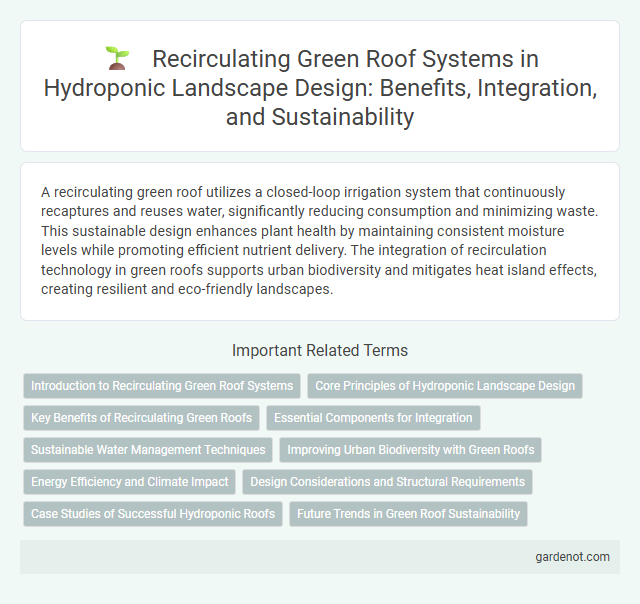A recirculating green roof utilizes a closed-loop irrigation system that continuously recaptures and reuses water, significantly reducing consumption and minimizing waste. This sustainable design enhances plant health by maintaining consistent moisture levels while promoting efficient nutrient delivery. The integration of recirculation technology in green roofs supports urban biodiversity and mitigates heat island effects, creating resilient and eco-friendly landscapes.
Introduction to Recirculating Green Roof Systems
Recirculating green roof systems utilize a closed-loop water system that continuously recycles nutrient-rich water to support plant growth, significantly reducing water consumption compared to traditional green roofs. These systems integrate hydroponic technology, enabling precise control of water and nutrient delivery, which enhances plant health and promotes efficient resource use in urban landscapes. By combining sustainable irrigation with green infrastructure, recirculating green roofs improve stormwater management and thermal regulation in buildings.
Core Principles of Hydroponic Landscape Design
Recirculating green roofs utilize a closed-loop hydroponic system that efficiently manages water and nutrient delivery by continuously cycling solution through plant roots, minimizing waste and ensuring optimal growth conditions. Core principles of hydroponic landscape design in this context include precise nutrient formulation tailored to specific plant species, maintaining balanced oxygenation and pH levels, and integrating lightweight, durable substrates to support root health while enabling effective drainage. These elements work synergistically to create sustainable, low-maintenance green roofs that promote biodiversity and improve urban microclimates.
Key Benefits of Recirculating Green Roofs
Recirculating green roofs enhance water efficiency by continuously cycling irrigation water, reducing overall consumption by up to 40%. These systems improve urban microclimates through superior thermal insulation, lowering building energy use by approximately 25%. Additionally, recirculating green roofs contribute to stormwater management by capturing and filtering nearly 70% of rainwater runoff, mitigating urban flooding risks.
Essential Components for Integration
Recirculating green roofs require essential components such as a waterproof membrane, a growing medium optimized for hydroponic systems, and an efficient nutrient delivery system that continuously circulates water and nutrients. A pump-driven irrigation system paired with a filtration unit ensures consistent water quality and prevents clogging, while integrated sensors monitor moisture levels and nutrient concentrations to optimize plant health. Properly sealed drainage layers and root barriers protect structural integrity and facilitate effective water recirculation within the hydroponic green roof setup.
Sustainable Water Management Techniques
Recirculating green roofs utilize advanced hydroponic systems to reduce water consumption by continuously recycling nutrient-rich water, minimizing runoff and evaporation. These sustainable water management techniques enhance urban water efficiency by incorporating sensors and automated controls to optimize irrigation scheduling based on real-time plant needs and weather conditions. The integration of rainwater harvesting and greywater reuse further supports resource conservation and improves the overall sustainability of green roof ecosystems.
Improving Urban Biodiversity with Green Roofs
Recirculating green roofs enhance urban biodiversity by creating sustainable habitats that support diverse plant and insect species within dense city environments. These systems continuously cycle nutrient-rich water through hydroponic layers, promoting healthy vegetation growth while reducing water consumption. Integrating recirculating green roofs into urban architecture fosters ecological corridors, improving air quality and providing refuge for pollinators and urban wildlife.
Energy Efficiency and Climate Impact
Recirculating green roofs enhance energy efficiency by reducing heat transfer through building roofs, lowering cooling and heating demands by up to 30%. The recirculation system conserves water by continuously reusing nutrient-rich solutions, minimizing both consumption and runoff. This approach significantly decreases the urban heat island effect and reduces carbon emissions associated with traditional HVAC energy use.
Design Considerations and Structural Requirements
Recirculating green roofs require careful design considerations including waterproofing integrity, drainage systems, and efficient recirculation pumps to sustain optimal nutrient flow and water retention. Structural requirements prioritize load-bearing capacity to support saturated growing media, plants, and water reservoirs, often necessitating reinforced roofing materials and support beams. Integration of lightweight, durable substrates and modular planting trays enhances both plant health and system maintenance efficiency in hydroponic landscapes.
Case Studies of Successful Hydroponic Roofs
Recirculating green roofs utilize hydroponic systems to efficiently recycle water and nutrients, significantly reducing resource consumption while enhancing urban biodiversity. Case studies like the Chicago City Hall green roof demonstrate substantial improvements in stormwater management and temperature regulation, coupled with increased crop yield from hydroponic planting beds. These successful installations highlight the scalability of recirculating hydroponic technology in enhancing rooftop sustainability and supporting local food production in dense urban environments.
Future Trends in Green Roof Sustainability
Recirculating green roofs represent a significant advancement in sustainable urban landscapes by efficiently reusing water and nutrients within closed-loop hydroponic systems, reducing waste and minimizing environmental impact. Future trends emphasize integrating smart sensors and AI-driven irrigation controls to optimize water conservation and plant health, further enhancing energy efficiency and resilience against climate variability. Innovations in lightweight, durable substrates and renewable energy-powered recirculation pumps are expected to make these systems more accessible and effective in diverse urban settings.
Recirculating green roof Infographic

 gardenot.com
gardenot.com